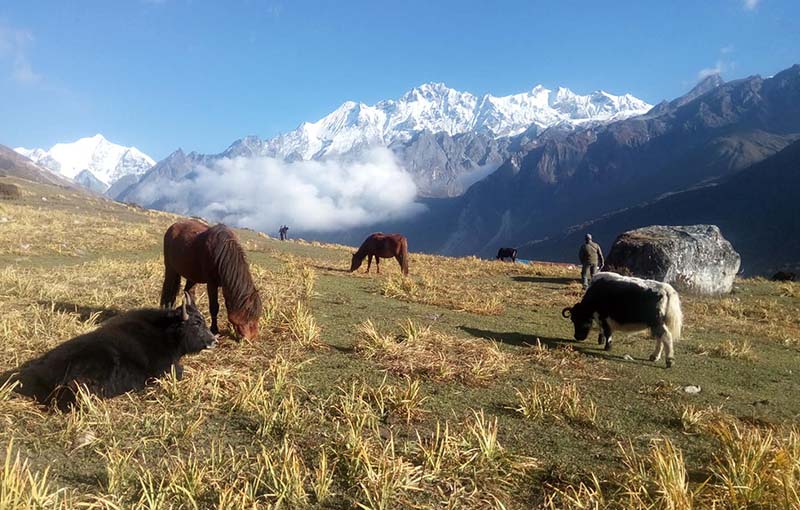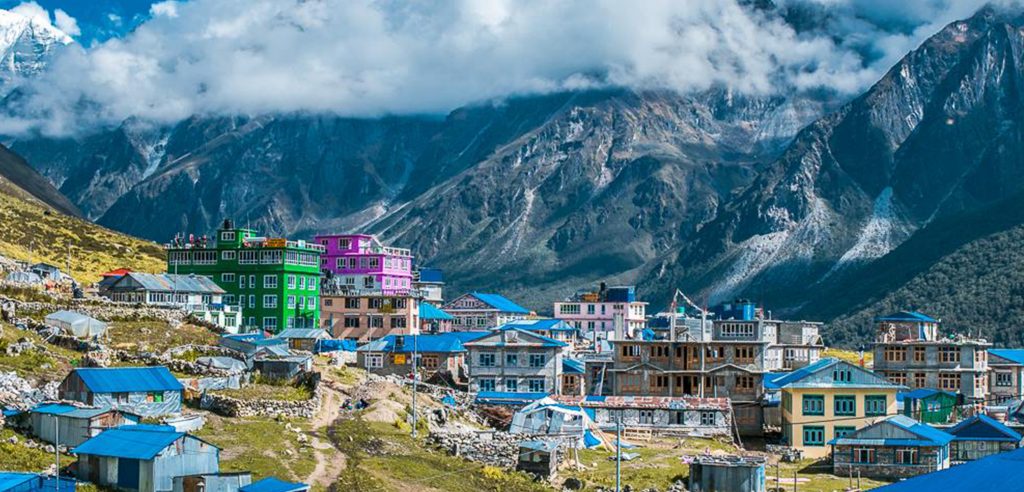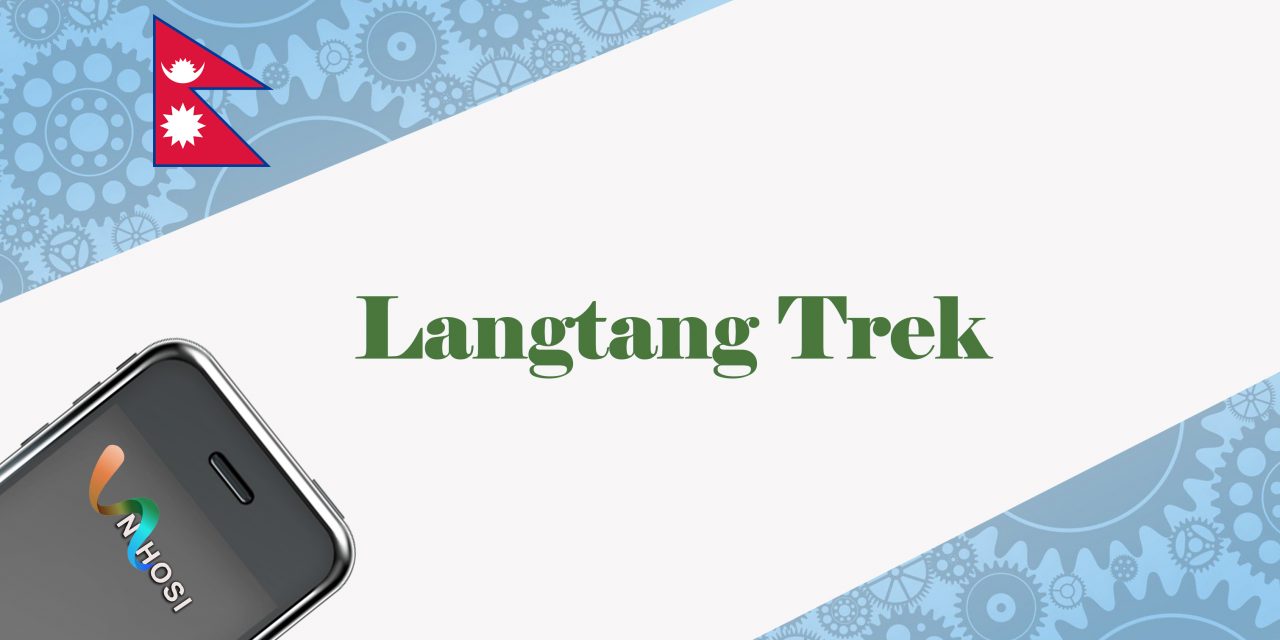Welcome to the breathtaking world of the Langtang Trek. Situated in the heart of the Himalayan nation of Nepal, this beautiful trek serves as a unique gateway to explore the region’s untouched landscapes and rich cultural heritage. This comprehensive guide aims to delve into the mystique of Langtang Valley, unravelling its scenic splendour, cultural nuances, and the exhilarating trekking experiences it offers.

The Charm of Langtang Trek: An Overview
Amidst Nepal’s snowy peaks and verdant valleys, the Langtang Trek unfurls as a treasured journey into the sublime. Home to a rich tapestry of flora and fauna, and nurtured by the timeless culture of the indigenous Tamang community, Langtang Valley promises a trekking adventure that is as enriching as it is thrilling. Every step along the winding trails of this Himalayan paradise offers a new story, a fresh perspective, and an unparalleled sense of wonder and awe.
The Langtang Trek not only captivates with its natural beauty but also mesmerises with its cultural richness. The local Tamang community, known for its Tibetan roots, warmth, and vibrant traditions, add to the unique charm of this journey. As you embark on this trek, you become a part of their age-old traditions, relish their distinct cuisine, and gain insights into their rustic way of life.

This guide aims to serve as your compass, guiding you through the enthralling trails, the cultural landmarks, and the fascinating ecology of the Langtang Valley. From preparation tips to insights into the local culture, we cover every aspect of the trek to help you make the most of your Langtang adventure.
So, are you ready to lace up your boots, put on your backpack, and embark on an unforgettable journey to the heart of the Himalayas? Let’s discover the magic and mysteries of the Langtang Trek!
The Charm of Langtang Trek: An Overview
Renowned as “the valley of glaciers”, Langtang Valley presents an unmatched blend of spectacular landscapes and vibrant cultures. The region, situated north of the bustling Kathmandu city, is home to a broad spectrum of geography – from verdant forests and serene alpine meadows to the rugged mountainous terrain adorned with gleaming glaciers.
Langtang Trek: A Hidden Paradise
Langtang Trek is often referred to as the ‘hidden paradise’ due to its pristine beauty and untouched landscapes. The trek, though less popular than the Annapurna and Everest treks, is a gem tucked away in the tranquil corners of Nepal. It’s a treasure trove for those seeking solace in the lap of the mountains, far from the maddening tourist crowds.
The journey commences from the quaint village of Syabrubesi, leading trekkers through dense forests, terraced fields, and traditional settlements, before unveiling the glacier-carved Langtang Valley. It’s a trail that’s dotted with ethereal landscapes – from the thundering waterfalls cascading down the lush green mountains to the tranquil blue lakes cradled in the valley.
What makes Langtang Trek a hidden paradise is its perfect blend of adventure and tranquillity. It’s not just about reaching the destination; it’s about soaking in the mesmerising sights, sounds, and smells along the way. Be it the glistening dew on the alpine foliage, the soft whispering of the breeze, or the distant roar of a waterfall, Langtang leaves no stone unturned to bewitch its visitors.
But perhaps, the highlight of the trek is the majestic views of the snow-laden peaks. Langtang Lirung, Dorje Lakpa, and Jugal Himal stand tall along the trail, their imposing facades illuminated in the golden hues of the sun. These are sights that capture the heart, etching deep within the soul, and making the arduous journey worth every effort.
The Langtang Trek, though lesser known, is a journey through paradise. It’s an experience that mesmerises, captivates, and leaves trekkers with a yearning to return to its ethereal beauty. It’s not just a trail; it’s a passage into the magical Himalayan wilderness, an experience of a lifetime.
The Flavour of Local Culture
What further distinguishes the Langtang Trek is the rich tapestry of culture it offers. The Tamang community inhabits the valley, an ethnic group with Tibetan roots. Their distinct culture, visible in the vibrant clothing, unique customs, and beautifully carved wooden houses, paints a colourful picture against the backdrop of the stark mountainous landscapes. Every village on the trail offers a chance to participate in their traditional way of life, making your trek a cultural immersion as much as a nature escapade.
A Bio-Diversity Hotspot
Langtang Valley’s diverse geography makes it a sanctuary for a wide variety of flora and fauna. As you traverse through the region, you’ll be treated to sights of blooming rhododendrons, oak and pine forests, and a myriad of wildlife, including the elusive red panda and snow leopard. The region is a dream come true for nature enthusiasts and wildlife lovers, adding another dimension to the trekking experience.
The Langtang Trek offers an unparalleled blend of nature, culture, and adventure. It’s more than just a trek – it’s a journey into the soul of Nepal, an adventure that promises to leave you with lasting memories and a longing to return.
Navigating the Trails of Langtang
While the allure of the Langtang Trek lies in its breathtaking landscapes and rich culture, the trek itself offers a rewarding challenge. The trail winds through diverse terrain, each presenting a different facet of the region’s beauty.
The Route to Langtang: Kyanjin Gompa
The classic Langtang Trek begins at Syabrubesi, a lively village that serves as the starting point for many treks in the region. From Syabrubesi, the trail meanders along the banks of the Bhote Kosi River, through dense bamboo forests and cascading waterfalls.
The route then leads to the Lama Hotel, not an actual hotel but a small settlement that provides a cosy respite for trekkers. The journey continues through the vibrant village of Mundu, its picturesque setting offering a glimpse into the local culture and lifestyle. As the trail ascends, it reveals the awe-inspiring Langtang Lirung Peak, a sight that is worth every bead of sweat shed on the journey.
The trek culminates at Kyanjin Gompa, a serene hamlet that seems straight out of a fairy tale. Home to an ancient monastery, a cheese factory, and panoramic views of the Langtang Range, Kyanjin Gompa is the perfect spot to rest, explore, and soak in the breathtaking vistas. This is also the ideal base for further excursions to Tserko Ri or Kyanjin Ri, both offering stunning sunrise views.
Best Time to Visit Langtang
Langtang Trek is a year-round destination, each season painting the valley in its unique hues. However, the best time to undertake this trek is during spring (March-May) and autumn (September-November). These seasons offer clear skies, moderate temperatures, and the best mountain views, making the trek an unforgettable experience.
Spring is when the entire valley blossoms with rhododendrons and wildflowers, creating a riot of colours against the stark white peaks. Autumn, on the other hand, offers clear, cloudless skies and unobstructed mountain views.
Regardless of the season, Langtang Trek is a mesmerising journey through nature’s splendour. It’s a path that navigates through verdant forests, charming hamlets, and the ever-present grandeur of the Himalayas. It’s a trek that leaves footprints in the sands of time, creating memories that linger long after the journey ends.
Flora and Fauna: Nature’s Melange
The Langtang Trek doesn’t just captivate with its high peaks and local culture. The region is a veritable sanctuary for an array of flora and fauna, offering nature lovers a unique opportunity to delve into the richness of Himalayan biodiversity.
Exotic Flora
The journey through Langtang unfolds like a botanical expedition, taking you through diverse vegetation zones. The lower altitudes are dominated by lush forests of oak, maple, and rhododendron. As you ascend, these give way to alpine scrub and meadows. During the spring season, the trail is ablaze with blooming rhododendrons, painting the valley in a riot of red, pink, and white. The scent of wildflowers in full bloom fills the air, enhancing the sensory delight of the trek.
Majestic Fauna
Langtang National Park, which encompasses the Langtang Valley, is home to a diverse range of wildlife. As you tread the winding trails, keep an eye out for the elusive red panda, the majestic snow leopard, the Himalayan tahr, and the black bear. The valley is also a birdwatcher’s paradise, with over 250 species of birds recorded, including the Himalayan Monal, Satyr Tragopan, and Ibisbill.
Whether it’s the fluttering of a colourful butterfly, the rustling of leaves signalling a hidden creature, or the sighting of an exotic bird, the Langtang Trek is interspersed with delightful encounters with nature. These experiences are as integral to the trek as the stunning landscapes, cultural exploration, and physical adventure. They create a symphony of sights, sounds, and experiences that define the unique allure of the Langtang Trek.
The Aftermath of the 2015 Earthquake and Recovery
The 2015 earthquake was a disaster that sent ripples of destruction across Nepal. Langtang Valley, due to its proximity to the epicentre, was one of the most heavily affected regions. The impact of the quake triggered a massive avalanche from Langtang Lirung, which wiped out Langtang Village entirely, leading to a tragic loss of life and property.
The Devastation
The Langtang Trek, a once-bustling trail, was left deserted in the wake of the catastrophe. Trekking routes were destroyed, local settlements were obliterated, and the region’s unique biodiversity was severely impacted. The tragedy was a severe blow to the community, whose livelihood primarily depended on trekking and tourism.
The Road to Recovery
In the aftermath of the disaster, the resilient spirit of the Langtang community shone through. They picked up the pieces and began the arduous task of rebuilding their homes and lives. Aid flowed in from all corners of the world, with volunteers working side by side with locals to restore the villages and trekking routes.
Fast forward to today, Langtang has not only recovered but also returned stronger. The trails have been restored, teahouses rebuilt, and the Langtang Trek has once again started to beckon trekkers from across the globe. The community, with its undying spirit and relentless efforts, has turned the valley back into the paradise it once was.
Every trek to Langtang is now a testament to the resilience of the human spirit and the power of community. While the signs of the disaster are there to be seen, they are symbols of hope, strength, and resilience, adding a deeper layer of meaning to the Langtang Trek.
Ensuring Responsible Tourism: Leave No Trace
While the Langtang Trek offers an enchanting journey through natural beauty and cultural richness, it’s crucial for visitors to adhere to the principles of responsible tourism. The ethos of ‘Leave No Trace’ not only helps preserve the environment but also ensures a sustainable future for the region.
Practising Minimal Impact
Adhering to the ‘Leave No Trace principle starts with practising minimal impact while trekking. Trekkers should avoid disturbing the natural environment and refrain from picking plants or disturbing wildlife. Proper waste management is another critical aspect – all waste should be carried out of the park or disposed of at proper waste disposal sites. Open fires are strictly prohibited, as they can lead to forest fires and disrupt the natural habitat.
Respecting Local Culture
Responsible tourism also extends to respecting the local culture. Trekkers should be mindful of local traditions, dress appropriately, and seek consent before photographing local people or religious sites. It’s also encouraged to support the local economy by purchasing local products and services.
Promoting Sustainable Tourism
The goal of responsible tourism is to ensure that the Langtang Trek can be enjoyed by future generations. This means promoting sustainable practices, such as using renewable energy sources, reducing water usage, and supporting conservation efforts. It’s about making a positive impact on the environment, society, and economy, ensuring a sustainable and inclusive future for Langtang.
In the grandeur of the Langtang Trek, every step taken with respect and responsibility ensures the longevity of this beautiful landscape. As we journey through its winding trails, let’s leave nothing but footprints, take nothing but pictures, and kill nothing but time.
FAQs About Langtang Trek
Preparing for the Langtang Trek often brings up numerous questions. Here, we address some of the most frequently asked questions to help you plan your trek better.
1. How difficult is the Langtang Trek?
Langtang Trek is considered moderate in terms of difficulty. While it doesn’t require any technical climbing skills, the high altitude and daily treks can be challenging. Proper acclimatisation, physical fitness, and a good trekking pace are crucial for a successful trek.
2. What is the best time to undertake the Langtang Trek?
The best time to undertake the Langtang Trek is during spring (March-May) and autumn (September-November). These seasons offer the most favourable weather conditions and clear views of the mountain ranges.
3. What kind of accommodation can I expect?
The Langtang Trek is a teahouse trek, which means you’ll be staying in local lodges or ‘teahouses’ along the trail. These offer basic accommodation with beds and shared bathrooms, and they provide meals.
4. Do I need a guide for the Langtang Trek?
While it’s possible to trek independently, hiring a guide can enhance your trekking experience. A guide not only helps with navigation but also provides valuable insights into the local culture and environment.
5. What should I pack for the Langtang Trek?
Your packing list should include warm clothing, trekking shoes, a first aid kit, water purification tablets, sunscreen, sunglasses, a good quality sleeping bag, and high-calorie snacks. Remember, it’s essential to pack light but ensure you have all your necessities.
The Langtang Trek is an experience that leaves a lasting impression. If you have any other questions or need further information, feel free to ask. The mountains are calling, and we’re here to help you answer!
Conclusion
The Langtang Trek offers an immersive experience that paints unforgettable impressions on the canvas of trekkers’ hearts. Traversing some of the most pristine landscapes on Earth, the trek introduces vibrant culture steeped in history and presents an incredible array of biodiversity. As trekkers engage with the friendly locals and come face-to-face with majestic peaks, the trek becomes a testament to the resilience of nature and the human spirit.
The adventure awaits regardless of the trekking experience, and Langtang Valley is ready to welcome all with its open arms and untold stories. With the services offered by Nihosi Travels, trekking experiences become enriching and hassle-free. Through customised trekking packages, guided tours, and complete assistance, the ethereal beauty of Langtang and beyond can be thoroughly enjoyed.
Why wait when the mountains are calling? An unforgettable journey awaits in the Langtang Valley. It’s time to lace up boots, embrace the adventure, and create memories to be cherished forever.











Subscribe To Our Newsletter
Join our mailing list to receive the latest news and updates from our team.
You have Successfully Subscribed!